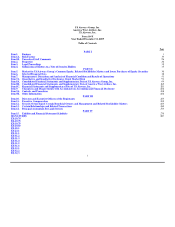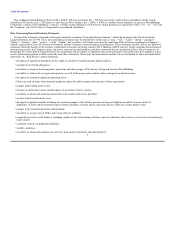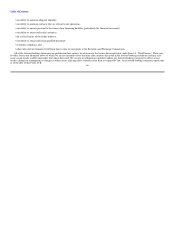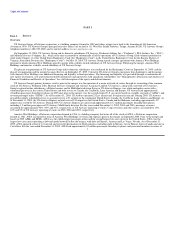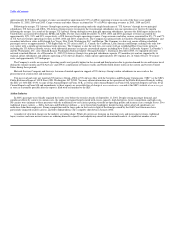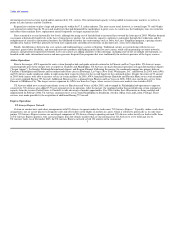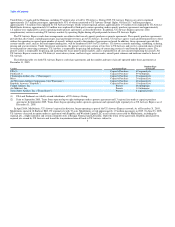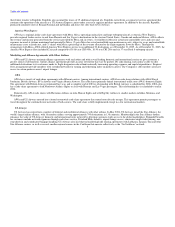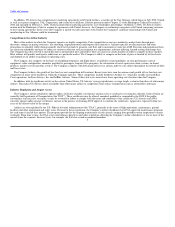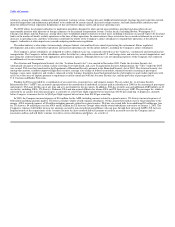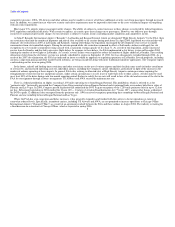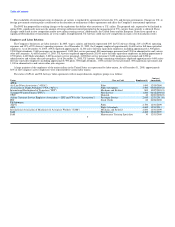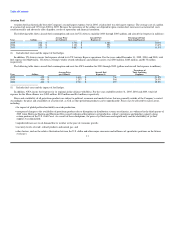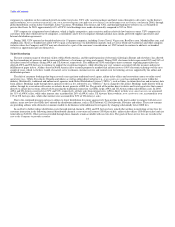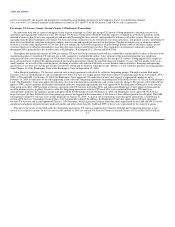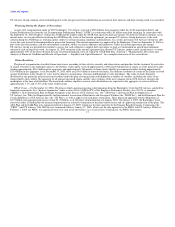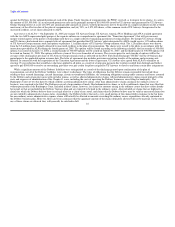US Airways 2005 Annual Report Download - page 14
Download and view the complete annual report
Please find page 14 of the 2005 US Airways annual report below. You can navigate through the pages in the report by either clicking on the pages listed below, or by using the keyword search tool below to find specific information within the annual report.
Table of Contents
competitive pressure, AWA, US Airways and other airlines may be unable to recover all of these additional security costs from passengers through increased
fares. In addition, we cannot forecast what new security and safety requirements may be imposed in the future or the costs or financial impact of complying
with any such requirements.
Most major U.S. airports impose passenger facility charges. The ability of airlines to contest increases in these charges is restricted by federal legislation,
DOT regulations and judicial decisions. With certain exceptions, air carriers pass these charges on to passengers. However, our ability to pass-through
security fees and passenger facility charges to our customers is subject to various factors, including market conditions and competitive factors.
At John F. Kennedy International Airport ("Kennedy"), LaGuardia and Reagan National, which are designated "High Density Airports" by the FAA, there
are restrictions that limit the number of departure and arrival slots available to air carriers during peak hours. In April 2000, legislation was enacted that will
eliminate slot restrictions in 2007 at LaGuardia and Kennedy. Among other things, the legislation encouraged the development of air service to smaller
communities from slot-controlled airports. During the interim period while slot restrictions remained in effect at LaGuardia, airlines could apply for slot
exemptions to serve smaller communities using aircraft with a maximum seating capacity of less than 71. As a result of this legislation, airlines increased
service from LaGuardia, and this led to excessive flight delays. In response to these delays, the FAA implemented a slot lottery system in December 2000
limiting the number of new flights at LaGuardia. As a result, several airlines were required to reduce the number of flights added at LaGuardia. The resulting
allocation of slots from the slot lottery system was initially scheduled to expire on September 15, 2001, but was subsequently extended through 2006. As a
result of the 2007 slot elimination, the FAA has indicated an intent to rethink its approach to regulating operations at LaGuardia. Several proposals, including
auctions, congestion pricing and other market-based solutions, are being considered along with more traditional regulatory approaches. The Company expects
a rule-making on this issue in spring 2006.
In the future, takeoff and landing time restrictions and other restrictions on the use of various airports and their facilities may result in further curtailment
of services by, and increased operating costs for, individual airlines, including the Company's airline subsidiaries, particularly in light of the increase in the
number of airlines operating at these airports. In general, FAA rules relating to allocated slots at High Density Airports contain provisions requiring the
relinquishment of slots for non-use and permit carriers, under certain circumstances, to sell, lease or trade their slots to other carriers. All slots must be used
on at least 80% of the dates during each two-month reporting period. Failure to satisfy the use rate will result in loss of the slot and reversion of the slot to the
FAA for reassignment through a lottery arrangement. US Airways and AWA exceed the minimum use rate.
There is a federal prohibition on flights exceeding 1,250 miles operating to or from Reagan National. This prohibition, which is referred to as the
"perimeter rule," historically prevented the Company from flying nonstop between Reagan National and its principal hubs or secondary hubs/focus cities of
Phoenix and Las Vegas. In 2000, Congress passed legislation that authorized the DOT to grant exceptions to the 1,250-mile perimeter rule for up to 12 slots
per day. Subsequent legislation in 2004 entitled the Vision 100 — Century of Aviation Reauthorization Act ("Vision 100"), among other things, authorized
the DOT to grant 12 additional slots exempted from the perimeter rule. AWA received exemptions permitting three roundtrips between Reagan National and
Phoenix and one roundtrip between Reagan National and Las Vegas.
Where the FAA has seen congestion and delay increases, it has generally stepped in and worked with the carriers to freeze operations at current or
somewhat reduced levels. Specifically, incumbent carriers, including US Airways and AWA, are not permitted to increase operations at Chicago O'Hare
International Airport ("Chicago O'Hare") as a result of an agreement reached between the FAA and these airlines in August 2004. The industry is waiting for
a final decision on restrictions at Chicago O'Hare, which is expected in spring 2006.
8


